Adipose-specific deletion of autophagy-related gene 7 (atg7) in mice reveals a role in adipogenesis
- PMID: 19910529
- PMCID: PMC2785257
- DOI: 10.1073/pnas.0906048106
Adipose-specific deletion of autophagy-related gene 7 (atg7) in mice reveals a role in adipogenesis
Abstract
White adipocytes have a unique structure in which nearly the entire cell volume is occupied by one large lipid droplet. However, the molecular and cellular processes involved in the cytoplasmic remodeling necessary to create this structure are poorly defined. Autophagy is a membrane trafficking process leading to lysosomal degradation. Here, we investigated the effect of the deletion of an essential autophagy gene, autophagy-related gene 7 (atg7), on adipogenesis. A mouse model with a targeted deletion of atg7 in adipose tissue was generated. The mutant mice were slim and contained only 20% of the mass of white adipose tissue (WAT) found in wild-type mice. Interestingly, approximately 50% of the mutant white adipocytes were multilocular. The mutant white adipocytes were smaller with a larger volume of cytosol and contained more mitochondria. These cells exhibited altered fatty acid metabolism with increased rates of beta-oxidation and reduced rates of hormone-induced lipolysis. Consistently, the mutant mice had lower fed plasma concentrations of fatty acids and the levels decreased at faster rates upon insulin stimuli. These mutant mice exhibited increased insulin sensitivity. The mutant mice also exhibited markedly decreased plasma concentrations of leptin but not adiponectin, lower plasma concentrations of triglyceride and cholesterol, and they had higher levels of basal physical activity. Strikingly, these mutant mice were resistant to high-fat-diet-induced obesity. Taken together, our results indicate that atg7, and by inference autophagy, plays an important role in normal adipogenesis and that inhibition of autophagy by disrupting the atg7 gene has a unique anti-obesity and insulin sensitization effect.
Conflict of interest statement
The authors declare no conflict of interest.
Figures
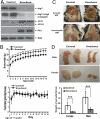
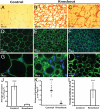
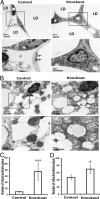
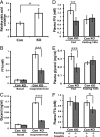

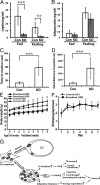
References
-
- Gesta S, Tseng YH, Kahn CR. Developmental origin of fat: Tracking obesity to its source. Cell. 2007;131:242–256. - PubMed
Publication types
MeSH terms
Substances
Grants and funding
LinkOut - more resources
Full Text Sources
Other Literature Sources
Medical
Molecular Biology Databases
Research Materials

